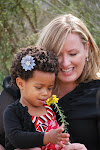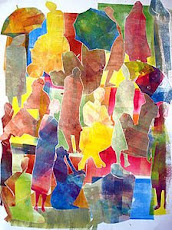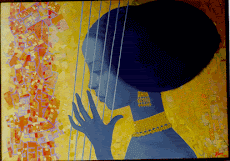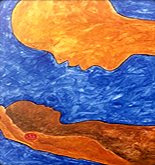 Pop open the champagne for Heather and Chris http://2b3soon.blogspot.com/
Pop open the champagne for Heather and Chris http://2b3soon.blogspot.com/I'm so happy for them and lucky for myself that I live so close to them and get to be a part of their happiness.
I found this article and although it's a little long, I think it's fascinating.
Artists’ Groups of the 1990s:
Motivating Forces Behind Contemporary Ethiopian Art
In the 1990s, as Ethiopia began to shift out of the socialist period, a group movement of various artists began in Addis Ababa. The most important and active groups were Addis International, Dimension Group, Friendship Of Women Artists (FOWA), and Point Group. As demonstrated in their occasional shows, the technical dexterity, proficiency and artistic intent of many of these artists had never been seen in the history of the country. Even pioneers of modern art and Zemenay artists, modernists of the 1960s, had not attained these artists’ level of education. The founding members of these groups, particularly members of the most influential Dimension group — studied art both at home and abroad for several years. They are highly qualified cultural individuals and patriotic artists.
The themes these artists shared in common were their opposition to and rejection of painting styles prevalent in the 1980s and the frustrating conditions they faced in the country. None of the groups discussed at any time the relationship between ideology and art, and none sponsored any kind of aesthetic ideology. Nor did they show interest in developing a unified style; they opted to be eclectic, open-minded and multi-dimensional. Despite the fact that each member’s individual creative aim differed greatly, they were close-knit groups apprehensive about getting help and recognition from individuals, the public, cultural centers, institutions and the government. As both precursors and products of the social and critical realism art movements, these politically conscious artists, become the New Masters and motivating force behind contemporary Ethiopian art.
By the beginning of the 1990s, an art movement had emerged that in many of its manifestations displayed little or no consistency or accepted style. Few of the members found it difficult to go solo or to move beyond the platform of the group in order to reinstate the concept of the artist as a “solitary genius.” By the end of the decade, many influential artists of these groups had abandoned explicitly social and political subjects. For the most part, contemporary Ethiopian art dissociated itself from issue-based themes, with the exception of those exhibitions sponsored and initiated by foundations and organizations. Soon after, the ‘isms’ of 20th century art and the tradition of Zemenay artists — the formalist, symbolist, decorative, surrealistic and expressive kinds of art — had become the mainstream. The most established painters were less strongly influenced by the formal approach and the theory of the Zemenay than were their students, the younger-generation painters. By the beginning of 2000, many of these artists had consciously turned away from the wider national audience, due in part to the special influence of private cultural centers and partly to the attendance of urban elites.
The grouping movement of the 1990s did help individual members to be successful in their artistic commitments. However, collectively, their ambitious and challenging goals still remain up in the air. For example, the Friendship of Women Artists (FOWA) — whose main purpose was “to encourage and enhance the opportunities of underrepresented women artists of all ages and to promote Ethiopian women artists in any way possible, nationally as well as internationally” — has directly or indirectly contributed to the sudden increase and successes of women artists. But FOWA did not come even close to achieving its stated goals. The Point group whose “motive was not to foster an elitist attitude, with the indifferent multitudes lost in oblivion, but rather to impress and influence it without any mystification whatsoever,” did not keep its promise either. The Dimension group, which claims it was “formed to overcome an artistic trend that has been going on in Ethiopia for quite some time - with little or no regard for the standards of the art-loving public of Addis Ababa” has not really come up with a solution. Its annual exhibition caters to a specific type of audience and not necessarily to the art-loving public of Addis Ababa - Ethiopia. Although working in a country with a growing demand to learn about and from art, even their catalogues were written only in English language. Moreover, the artists have been preoccupied in arguing with critics who question the validity of their group’s origin. Even if these artists cannot fairly be criticized as being too elitist, ultimately many of their attempts on behalf of the art-loving public end up being fodder for nay-sayers who still associate art only with intellectuals and academia. It will not be a surprise if the next generation of artists continues to complain about the inability of the public to grasp and understand their art.
Despite the fact that all groups’ ideas reflect a sincere wish for profound changes in the visual art culture of the nation, there never was any real attempt by any of them to show their work to a bigger audience outside of Addis Ababa. No preparations for any kind of art publications were made, and none of the groups tried to form an alliance to link the many groups and individual artists. There was no attempt to create an association that promotes art and protects artists' social, legal and economic interests. There is no association that seeks to influence topical issues involving cultural policy, such as the nation’s art budget and the funding of art purchases by public entities in order to increase the public's interest in art. Most importantly, none of the groups attempted to create an association that is seriously needed to link Ethiopian artists closer with international artists’ networks, particularly African ones.
Their predecessors — the artists of the 1940s and 1960s, even with their limited freedom, education and opportunities — were ambitious enough to open art schools, to popularize modern art and art education and show a pioneering spirit. Even the student group of the Addis Ababa School of Fine Arts in the 1960s and 1970s, the Young Artists group, and the Ethiopian Painters Association — , which of course was short-lived — worked with the intention to make modern art transparent and accessible to the public. Their genuine concern and long-held desire for art to flourish in the nation, and their striving to be a meaningful source of cultural empowerment for possibly social change gave these artists the chance to exert influence among younger generation artists and their supporters.
While there is no denying that the New Masters are proud of their predecessors and were able to infuse post-Derg art with fresh energy, they nevertheless did not succeed in addressing the problems and overcome the obstacles and the challenges their predecessors faced. Even after learning and seeing the global artistic change and crises, these artists are still very much surround and enchanted by the reputation of their predecessors’ accomplishments, great promise and artistic traditions. It appears that the formation of these groups was not based on life experience, traumatic imprints or even political and ideological influences during an important period in their artistic development, but rather by purely emotional involvement and passion. Unfortunately, passion alone is not enough to feed a cause.
Modern Ethiopian artists including these artists’ groups, are set apart from many other contemporary artists worldwide because, they all are full-time government or private employees and do not depend on the sales of their work for their livelihood and security. (Few early modern painters in the 1920s and 1930s and couple other Zemenay painters depended on the sales of their work for their survival.) Despite the fact that these groups possessed the quality and education levels of modern intellectual artists, as well as artistic freedom and opportunity, they did not play significant roles in winning the support of individuals or institutions — national patrons who could have promoted their art. Consequently, for lack of grants, gifts or contributions from individuals, the public or from the government, many of the groups disintegrated in less than 10 years.
The challenges facing Ethiopian artists are the challenges facing Ethiopian society. They are easy to identify, but are not that simple to resolve. These challenges did not suddenly appear unexpectedly — their roots are long and deep. The key factor that has defined Ethiopian artists in the 20th century has been bigger than art - it is Ethiopianness. Presently, visual artists hardly support themselves solely through their art and their pathetic survival condition is spurring many of the best and brightest new generation artists to exit the country and permanently reside abroad. In light of the postmodern art world uncertainty, and considering the kind of education and training artists receive, perhaps before long the essential contemporary question will be this: Should 21st century Ethiopian artists prioritize their survival and their creative futures above all else?
By: Esseye Medhin, January 14, 2007
Artists’ Groups of the 1990s:
Motivating Forces Behind Contemporary Ethiopian Art
In the 1990s, as Ethiopia began to shift out of the socialist period, a group movement of various artists began in Addis Ababa. The most important and active groups were Addis International, Dimension Group, Friendship Of Women Artists (FOWA), and Point Group. As demonstrated in their occasional shows, the technical dexterity, proficiency and artistic intent of many of these artists had never been seen in the history of the country. Even pioneers of modern art and Zemenay artists, modernists of the 1960s, had not attained these artists’ level of education. The founding members of these groups, particularly members of the most influential Dimension group — studied art both at home and abroad for several years. They are highly qualified cultural individuals and patriotic artists.
The themes these artists shared in common were their opposition to and rejection of painting styles prevalent in the 1980s and the frustrating conditions they faced in the country. None of the groups discussed at any time the relationship between ideology and art, and none sponsored any kind of aesthetic ideology. Nor did they show interest in developing a unified style; they opted to be eclectic, open-minded and multi-dimensional. Despite the fact that each member’s individual creative aim differed greatly, they were close-knit groups apprehensive about getting help and recognition from individuals, the public, cultural centers, institutions and the government. As both precursors and products of the social and critical realism art movements, these politically conscious artists, become the New Masters and motivating force behind contemporary Ethiopian art.
By the beginning of the 1990s, an art movement had emerged that in many of its manifestations displayed little or no consistency or accepted style. Few of the members found it difficult to go solo or to move beyond the platform of the group in order to reinstate the concept of the artist as a “solitary genius.” By the end of the decade, many influential artists of these groups had abandoned explicitly social and political subjects. For the most part, contemporary Ethiopian art dissociated itself from issue-based themes, with the exception of those exhibitions sponsored and initiated by foundations and organizations. Soon after, the ‘isms’ of 20th century art and the tradition of Zemenay artists — the formalist, symbolist, decorative, surrealistic and expressive kinds of art — had become the mainstream. The most established painters were less strongly influenced by the formal approach and the theory of the Zemenay than were their students, the younger-generation painters. By the beginning of 2000, many of these artists had consciously turned away from the wider national audience, due in part to the special influence of private cultural centers and partly to the attendance of urban elites.
The grouping movement of the 1990s did help individual members to be successful in their artistic commitments. However, collectively, their ambitious and challenging goals still remain up in the air. For example, the Friendship of Women Artists (FOWA) — whose main purpose was “to encourage and enhance the opportunities of underrepresented women artists of all ages and to promote Ethiopian women artists in any way possible, nationally as well as internationally” — has directly or indirectly contributed to the sudden increase and successes of women artists. But FOWA did not come even close to achieving its stated goals. The Point group whose “motive was not to foster an elitist attitude, with the indifferent multitudes lost in oblivion, but rather to impress and influence it without any mystification whatsoever,” did not keep its promise either. The Dimension group, which claims it was “formed to overcome an artistic trend that has been going on in Ethiopia for quite some time - with little or no regard for the standards of the art-loving public of Addis Ababa” has not really come up with a solution. Its annual exhibition caters to a specific type of audience and not necessarily to the art-loving public of Addis Ababa - Ethiopia. Although working in a country with a growing demand to learn about and from art, even their catalogues were written only in English language. Moreover, the artists have been preoccupied in arguing with critics who question the validity of their group’s origin. Even if these artists cannot fairly be criticized as being too elitist, ultimately many of their attempts on behalf of the art-loving public end up being fodder for nay-sayers who still associate art only with intellectuals and academia. It will not be a surprise if the next generation of artists continues to complain about the inability of the public to grasp and understand their art.
Despite the fact that all groups’ ideas reflect a sincere wish for profound changes in the visual art culture of the nation, there never was any real attempt by any of them to show their work to a bigger audience outside of Addis Ababa. No preparations for any kind of art publications were made, and none of the groups tried to form an alliance to link the many groups and individual artists. There was no attempt to create an association that promotes art and protects artists' social, legal and economic interests. There is no association that seeks to influence topical issues involving cultural policy, such as the nation’s art budget and the funding of art purchases by public entities in order to increase the public's interest in art. Most importantly, none of the groups attempted to create an association that is seriously needed to link Ethiopian artists closer with international artists’ networks, particularly African ones.
Their predecessors — the artists of the 1940s and 1960s, even with their limited freedom, education and opportunities — were ambitious enough to open art schools, to popularize modern art and art education and show a pioneering spirit. Even the student group of the Addis Ababa School of Fine Arts in the 1960s and 1970s, the Young Artists group, and the Ethiopian Painters Association — , which of course was short-lived — worked with the intention to make modern art transparent and accessible to the public. Their genuine concern and long-held desire for art to flourish in the nation, and their striving to be a meaningful source of cultural empowerment for possibly social change gave these artists the chance to exert influence among younger generation artists and their supporters.
While there is no denying that the New Masters are proud of their predecessors and were able to infuse post-Derg art with fresh energy, they nevertheless did not succeed in addressing the problems and overcome the obstacles and the challenges their predecessors faced. Even after learning and seeing the global artistic change and crises, these artists are still very much surround and enchanted by the reputation of their predecessors’ accomplishments, great promise and artistic traditions. It appears that the formation of these groups was not based on life experience, traumatic imprints or even political and ideological influences during an important period in their artistic development, but rather by purely emotional involvement and passion. Unfortunately, passion alone is not enough to feed a cause.
Modern Ethiopian artists including these artists’ groups, are set apart from many other contemporary artists worldwide because, they all are full-time government or private employees and do not depend on the sales of their work for their livelihood and security. (Few early modern painters in the 1920s and 1930s and couple other Zemenay painters depended on the sales of their work for their survival.) Despite the fact that these groups possessed the quality and education levels of modern intellectual artists, as well as artistic freedom and opportunity, they did not play significant roles in winning the support of individuals or institutions — national patrons who could have promoted their art. Consequently, for lack of grants, gifts or contributions from individuals, the public or from the government, many of the groups disintegrated in less than 10 years.
The challenges facing Ethiopian artists are the challenges facing Ethiopian society. They are easy to identify, but are not that simple to resolve. These challenges did not suddenly appear unexpectedly — their roots are long and deep. The key factor that has defined Ethiopian artists in the 20th century has been bigger than art - it is Ethiopianness. Presently, visual artists hardly support themselves solely through their art and their pathetic survival condition is spurring many of the best and brightest new generation artists to exit the country and permanently reside abroad. In light of the postmodern art world uncertainty, and considering the kind of education and training artists receive, perhaps before long the essential contemporary question will be this: Should 21st century Ethiopian artists prioritize their survival and their creative futures above all else?
By: Esseye Medhin, January 14, 2007



















1 comment:
Recent research shows that yes Ladybugs do migrate at the end of the summer/early fall, but if the Do-it-your self farmer/gardener can improve the stay of their friendly Ladybug herd by providing them a nesting box, home or house. They eat other insects besides aphids like plant lice, whitefly and scale insects. Two years of research show that most ladybugs leave to look for a home they make home from a squirrel hollowed out hole in a tree where they become pray from birds. I have had good luck with a house designed for the Convergent lady beetle, Scientific name: Hippodamia convergens, which is native to California. The Best Lady Bug House takes in consideration of their basic needs: Location, Food, Shelter, Protection , and a nourishing Environment. visit web site http://www.thebestladybughouse.com
Post a Comment